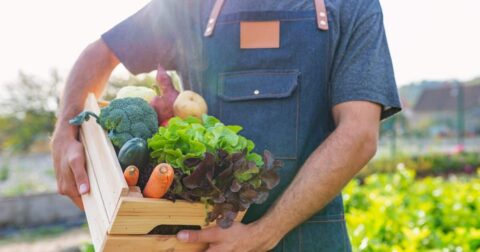News
Costco Chicken Processing Plant Keeps Failing Tests for Salmonella
Food•5 min read
Explainer
What makes a food "organic"? One survey found only 20 percent of respondents knew the answer.


Words by Björn Ólafsson
The organic food industry has experienced rapid growth in the past thirty years, with consumers of organics citing health and environmental sustainability as the top motivating factors for their shopping choices. In 2020, organic food comprised 6 percent of all food sales in the U.S., a big leap from just a decade earlier.
Yet at least one survey suggests only 20 percent of shoppers know what organic means. Confusing marketing campaigns and food labels aren’t helping. Here are the facts about organic food to help you make an informed decision at the grocery store.
In general, organic food is grown without synthetic chemicals — including pesticides, additives and preservatives.
The USDA has a set of regulations that define food as organic, including banned substances, standards for soil quality and banned genetically modified foods.
Organic foods must be grown, raised or produced without any of the following:
However, the following treatments are allowed:
Additionally, there are four levels of organic food:
Nearly any form of whole food can be grown organically, including tomatoes, cucumbers, meat products from animals such as cows or chickens and even honey or milk.
Not all locally grown food is organic and not all organic food is locally-grown. Organic food must be grown according to strict regulations, but may be flown or trucked in from elsewhere, while local food is made within 250 miles of the site of purchase, but may have been produced with a variety of methods, including using pesticides or bioengineered ingredients.
Consumers looking for organic produce should seek out the USDA Organic Label while those looking for locally grown foods can patronize farmer’s markets in their area.
Proponents of organic food often tout its supposed health and environmental benefits. But are these claims backed up by science?
It is difficult to compare broad categories of foods like organic and nonorganic in terms of healthfulness. It’s possible for organic packaged foods to contain large amounts of sugar and salt, for example, more than conventionally grown whole foods. In other words, an organic meal is not necessarily healthier just because of its organic status.
Measuring the health impacts of “pesticides” is tricky, as pesticides are not a single chemical but a broad category of treatments that all have very different impacts, from soil health to human health. Some pesticides are natural chemicals while others are synthetic, and all come with varying levels of toxicity. The dose, or how much is used, also makes a difference.
Studies have linked exposure to a number of pesticides to childhood health harms, including developmental delays, reduced cognitive capacity and, in some cases, increased risks of cancer. The bulk of these studies measured health impacts in communities with high exposures to pesticides, both agricultural communities and residents of urban buildings sprayed heavily with insecticides.
The levels of exposure that these communities experience are higher than the trace residues you consume when you eat an apple. Consumers should be sure to peel and wash food carefully to minimize exposure, but purchasing foods that are grown with minimal pesticides can help reduce future impacts to farm workers and their communities.
There are a few indirect public health benefits of organic food, especially concerning antibiotic use. Animal agriculture’s use of antibiotics, estimated to total 6 million kilograms in the U.S. in 2021, contributing to antibiotic resistance leading to the deaths of 35,000 Americans and over a million more worldwide.
Organic agriculture could help reduce these deaths by lessening the prevalence of disease-resistant illness. Reducing meat consumption is even more effective.
Minimizing pesticide use offers a huge benefit to the environment. Some pesticides enter local rivers and other water sources, polluting nearby soil and causing harm to local animals like insects, birds, fish and rodents.
In the U.S., insect populations are declining at an extremely alarming rate, leading some scientists to dub the phenomenon an insect apocalypse. The American agriculture industry is 48 times more toxic than it was in the 1990s, due in large part to a specific form of insecticide called neonicotinoids. As insect populations decline, especially insects that pollinate plants like local bee species, entire ecosystems are thrown out of balance, including plants and animals, predators and prey.
Thankfully, organic farms are not permitted to use neonicotinoids, which may help with this massive problem. Unfortunately, research shows that 93 percent of soils used in organic agriculture show residue of neonicotinoids, likely from nearby farms or past farming practices.
Despite popular belief, organic food can be grown with certain pesticides, although most synthetic pesticides are not allowed. The USDA lists 10 synthetic insecticides that are allowed for organic produce: ammonium carbonate, aqueous potassium silicate, boric acid, copper sulfate, elemental sulfur, lime sulfur including calcium polysulfide, horticultural oils, insecticidal soaps, sticky traps/barriers and sucrose octanoate esters. However, some of these substances are regulated further as to how they can be used.
For organic livestock production other synthetic materials are allowed, including formic acid and oxalic acid for honeybees.
There are extensive debates about environmental benefits and drawbacks of organic food. In short, it depends.
Limiting pesticide use certainly benefits the environment. However, many types of organic food require more land to produce than their conventional counterparts. By one estimate, an organic product requires 25 to 110 percent more land than the same product conventionally farmed. Land use is concerning, especially considering that 46 percent of the Earth’s habitable surface is already utilized by the agricultural industry, much of it having been deforested. Organic farming also requires approximately 1.7 times more direct energy input to create the same amount of food.
Organic food has not been shown to help reduce greenhouse gas emissions. According to a 2020 research study, organic meat production does not emit fewer greenhouse gases than conventional livestock farms.
The meat industry is by far the largest contributor to greenhouse gas emissions in the agriculture sector, contributing at least 16.5 percent of all human-caused carbon dioxide-equivalent emissions. Consumers who wish to reduce their greenhouse gas emissions through food purchases should buy more plant-based foods instead of organic meat. Some research indicates that organic plant-based foods are the lowest emitters overall.
There are a few welfare advantages for animals raised on organic farms as opposed to traditional farms. They must have been raised on farms that “accommodate their natural behaviors” according to the USDA, although “natural behaviors” is not explicitly defined. The animals must be given a diet of organic feed and may not be given antibiotics or hormones.
However, there are a number of ethical standards not mandated by organic agriculture. Animals may be branded, dehorned, debeaked or otherwise mutilated by farmers. Organic dairy farms remove calves from their mothers, even though cows are incredibly social creatures who are emotionally scarred by this practice. Animals in many organic farms can still suffer injuries and infections.
While organic farming does require that animals spend some time outdoors, some of their time is still spent inside in what are still cramped conditions. This can lead to animals displaying harmful behaviors, such as biting and pecking. According to one study, outdoor rearing as practiced in organic farming does not prevent tail-biting among pig populations, likely because the animals are kept in large herds that are not seen in the wild.
Animals on organic farms are also killed when it is profitable for the farmers, not to maximize the welfare of the animals. Therefore, animals live only fractions of their natural lifespan. Organic farming also gives no instructions on slaughtering, meaning that animals can be killed in horrific and inhumane ways, such as by suffocation or electrocution.
In short, organic farming tends to have some advantages over traditional animal farming, but it is a stretch to argue that organic farming is good for animals.
Farmers who comply with organic regulations may send an application to a USDA-accredited certifying agent, who then reviews the application and verifies that it meets the USDA standards. To confirm, a USDA inspector will visit the farm site and check the operation; if the standards are met, the USDA organic label is approved.
The farmers must go through an annual inspection process to ensure their standards do not falter. Additionally, ordinary citizens and watchdog groups can file complaints about specific farms. The National Organic Program can then file cease-and-desist orders to stop farms using the organic label, give farms a warning or even fine farmers for misuse of agricultural products.
The rigorous process required to become an organic farm is also responsible for the potentially hefty price tag. Farms must comply with regulations, meaning that more labor is required, and organic farms struggle to reach an economy of scale that allows for lower prices. These smaller volumes of food also create other potential hangups: higher marketing costs, higher packaging costs or even higher transportation fees.
There are some benefits to organic agriculture, like reduced pesticide and antibiotic use. However, organic food systems at scale would not curb agriculture’s massive land use, greenhouse gas emissions or animal suffering.
Reducing meat consumption in favor of a plant-rich diet can have a bigger impact. Check out our Take Action page for more resources.